
Webinar: Tuesday, April 29th @1pm
Winning at Retention-
Proven Strategies to Reduce Cancellations, Winback Customers & Drive Lifetime Value
Sign up Now
One of the greatest salespeople of all time was born nearly a century and a half ago on a farm in Ohio. His name was John Henry Patterson, and if he were alive today he’d fire most of the salespeople reading this post.
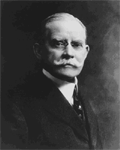
Brilliant, innovative, dictatorial, and mercurial, Patterson is best remembered today as the founder of the National Cash Register Company (NCR).
John Henry Patterson’s favorite quote: “You must make your mark on this earth, and, if you have never done so, it is simply because you neglected to use the powers you have, or you have neglected to develop them.”
More significant but virtually forgotten is the fact that this mustachioed, bespectacled whirlwind of a man invented modern selling. The sales-training manual, canned presentation, protected territory, and quota system are all products of Patterson’s fertile mind. So are sales meetings, direct mail, testimonials, industrial advertising, and publicity.
So numerous were his contributions during his tenure at the NCR (1884-1922) and so vast was his influence that Patterson may rightly be called the Father of Professional Selling. And perhaps even the Father of the Modern American Corporation, for many of those whom Patterson trained went on to found corporations such as IBM, (Patterson’s sales manager was Thomas Watson Sr.) and Burroughs.
Single-handedly and often opposed by business associates and the salespeople who benefited from his genius, Patterson created the greatest selling machine this country has ever seen. It may even be said that no company today approaches the marketplace efficiency that Patterson’s NCR achieved in its heyday. Too frequently the practices he pioneered are preached but not followed.
Few companies have had more inauspicious beginnings than the NCR. When Patterson, at the age of 40, bought controlling interest in the failing Dayton, OH, firm in 1884, there was literally no market demand for cash registers. Fewer than 400 had ever been sold, for several reasons.
The NCR factory employed women who worked shorter hours than men, and they were allowed to bring their children, who spent time playing in the NCR nursery.
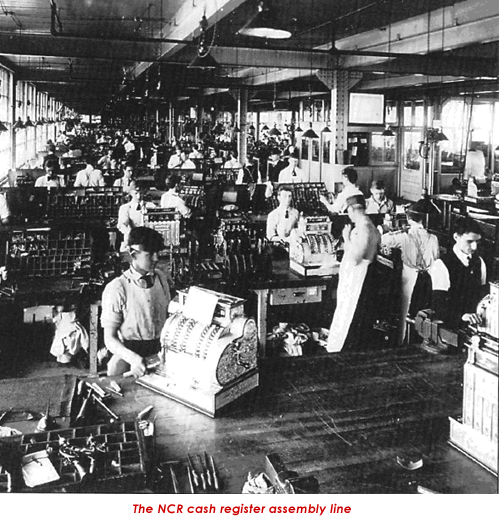
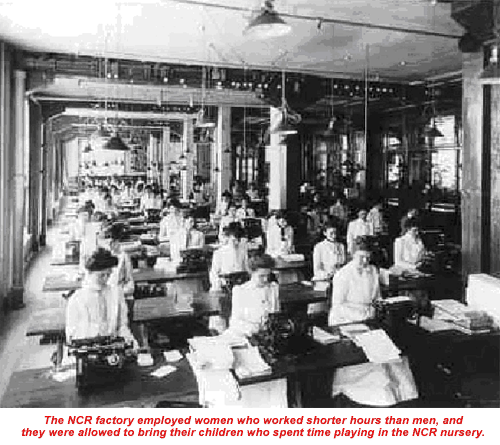
Few retail businesses, the targeted market, appreciated the value of a device they viewed as a kind of Rube Goldberg machine. Clerks who felt the cash register represented a mechanical intruder sent to spy on their integrity were openly hostile to salesmen who came through the door lugging a demonstration cash register. Poor craftsmanship sometimes forced the return of thousands of dollars worth of machines.
Finally, there was the problem of the salespeople themselves. Slovenly, disorganized, ill-prepared, and uncommitted to either the company or product, they almost seemed to stand in the way of sales.
These problems would have sunk most entrepreneurs with a fledgling business, but not Patterson. He was one of those rare human beings whose vision and resoluteness enabled him to achieve divine solutions where other men saw only a quagmire of frustration.
It was with the same single-mindedness that Patterson set out to transform the NCR. A salesman dedicated to professionalism, he believed that improving salespeople was the surest path to success, and that was where he concentrated his efforts. Patterson set out to change the art and science of selling.
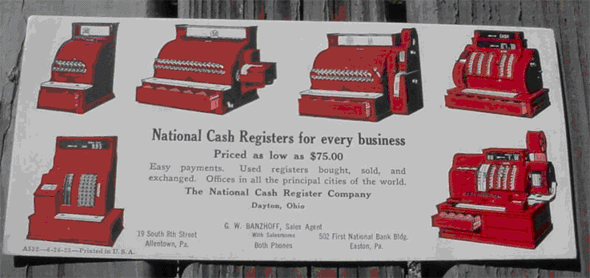
Patterson was one of the first in the country who was sold – through personal experience – on the value of the cash register. A pair of registers he bought for his retail store cut his debt from $16,000 to $3,000 in six months and helped him show a profit of $5,000. It was that experience that led him to buy the company.
But Patterson was virtually alone as a true believer. So when he bought the company that would become the NCR, his first task was to create awareness of and then demand for the product.
Patterson did this in a way that stunned the business community of the day; through the heavy (even relentless) use of advertising, direct mail, and publicity. In so doing, he raised advertising and promotion to unprecedented levels of sophistication and created models still in use today.
Often it was a process of trial and error. In his first direct-mail effort, Patterson spent thousands of dollars developing a circular for 5,000 prospects. “It was a good piece, but it did not contain a picture of the cash register,” said Patterson. NCR received not one response from that campaign.
Still convinced of the value of direct mail, Patterson continued his experiments, learning as he went and distributing circulars by the millions. Some circulars were in letter form, some included pictures, and others dramatized the use of the cash register. Many were in the form of publications directed to specific groups of retailers. To thwart antagonistic retail clerks, Patterson devised the idea of using plain envelopes and often had the pieces mailed from cities other than Dayton.
In one of his most inspired moments, Patterson hit on the idea of incorporating praise from satisfied customers in direct mail. These testimonials proved among the strongest cases ever devised to sway prospects. They were “living” arguments to buy.
Patterson spent a fortune on paving the way for his salespeople through the mail. Stockholders and employees tore their hair out at that expense, and the post office had to hire additional postal clerks just to handle the influx from NCR mailings. Not content to rely on direct mail, Patterson turned his attention to print advertising. At the time, advertising was most notable for its stuffiness; reliance on baroque graphics; and lengthy, tedious copy. Patterson did for advertising what Frank Lloyd Wright did for architecture – simplified it and made it easier on the eye. Not incidentally, he vastly improved its effectiveness.
Patterson’s motto for NCR ad copywriters was “be direct and simple.” The copy was kept brief and to-the-point. Ads were printed in plain type styles and were broken up with ample blank space. Patterson liked pictures galore in his ads, provided they were pleasant, upbeat, and “something out of the ordinary” to attract attention.
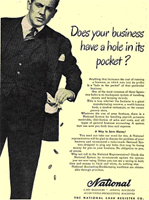
Patterson wanted his ads to sell the need, not the product. He insisted on simplicity and single-minded focus, saying, “No ad is big enough to sell two ideas.”
In conjunction with direct-mail and print advertising, Patterson also developed the industrial publicity release. “Business is news,” he believed, and so he hired publicists to generate articles by the score on NCR products and activities.
In the end, Patterson’s “wild ideas” about promotion were upheld. Prospects who had never before heard of the cash register, let alone NCR, were regularly bombarded with a cleverly coordinated mixture of direct-mail flyers, print ads, and NCR articles. Those who had previously been unaware of the product suddenly began to develop a need for it.
Unfortunately, the sales force wasn’t always in shape to take advantage of Patterson’s ingenious efforts. Many knew less about NCR products than did the copywriters. (See part II tomorrow)
Get the latest sales leadership insight, strategies, and best practices delivered weekly to your inbox.
Sign up NOW →